This set of Linear Integrated Circuit Multiple Choice Questions & Answers (MCQs) focuses on “Input Offset Voltage – 2”.
1. Choose the compensating network design for non-inverting amplitude
a)
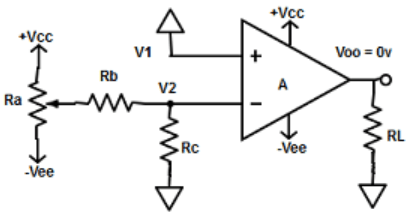
b)
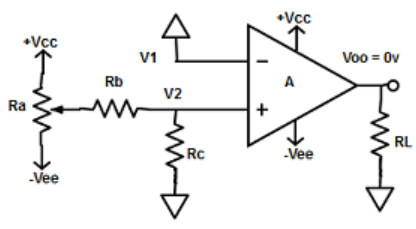
c)
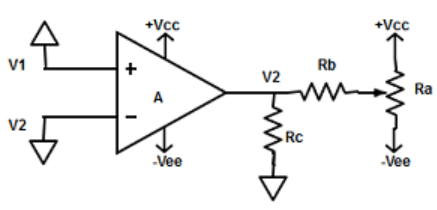
d) None of the mentioned
View Answer
Explanation: If an op-amp is used as an non-inverting amplifier, the compensating network should be connected to the inverting input terminal of the op-amp.
2. Find the thevenin’s equivalent for resistance and voltage?
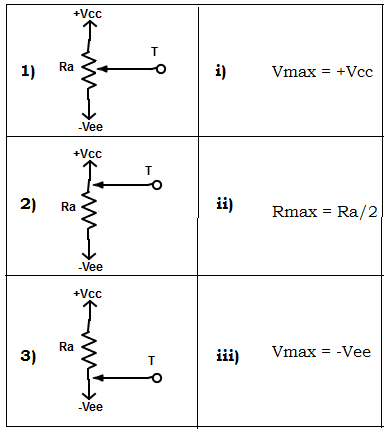
a) 1-iii, 2-ii, 3-1
b) 1-ii, 2-I, 3-iii
c) 1-I, 2-ii, 3-iii
d) 1-ii, 2-iii, 3-i
View Answer
Explanation: The maximum thevenin equivalent resistance Rmax occurs when the wiper is at the center of the potentiometer and the maximum thevenin equivalent voltage Vmax is equal to +Vcc or –Vee, when wiper is uppermost or lowest in the potentiometer.
3. What is done to compensate the voltage, when V1 > V2?
6. Find the value of Ra and Rb from the circuit shown?
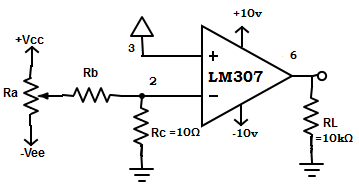

a) Ra =4.6kΩ ; Rb= 9kΩ
b) Ra =7.3kΩ ; Rb= 3.4kΩ
c) Ra =2.5kΩ ; Rb= 5.1kΩ
d) Ra =4kΩ ; Rb= 10kΩ
View Answer
Explanation: We know that input offset voltage, Vio =(Rc*Vmax)/ Rb
=> Rb = Vmax*(Rc / Rb ) = (10v/10mv)*10Ω (∵ Vio specified on the datasheet is 10mv for LM307 op-amp).
=> Rb =10000 = 10kΩ.
Since Rb > Rmax let us choose Rb = 10*Rmax. (Where Rmax = Ra/4).
∴ Rb = (10*Rb)/4 and Ra = Rb/2.5 = 10kΩ/2.5=4kΩ.
7. Why does an op-amp without feedback is not used in linear circuit application?
a) Due to high current gain
b) Due to high voltage gain
c) Due to high output signal
d) All of the mentioned
View Answer
Explanation: In an op-amp without feedback, the voltage gain is extremely high (ideally infinite). Because of the high risk of distortion and clipping of the output signal, an op-amp in open loop configuration is not used in linear circuit application.
8. When the input voltage is reduced to zero in a closed loop configuration the circuit acts as
a) Inverting amplifier
b) Non-inverting amplifier
c) Inverting and non-inverting amplifier
d) None of the mentioned
View Answer
Explanation: Since, the input signal voltage is reduced to zero, the internal resistance is negligibly small. The output offset voltage is expressed in terms of external resistance and the specified input offset voltage for a given op-amp.
If the non-inverting input terminal is connected to ground, it acts as inverting op-amp and vice versa.
9. How the value of output offset voltage is reduced in closed loop op-amp?
a) By increasing gain
b) By reducing gain
c) By decreasing bandwidth
d) By reducing bandwidth
View Answer
Explanation: The output offset voltage is a product of gain and specified input offset voltage for a given op-amp. Voo= Aoo*Vio. So, the value of output offset voltage can be reduced by reducing the gain value.
Sanfoundry Global Education & Learning Series – Linear Integrated Circuits.
To practice all areas of Linear Integrated Circuits, here is complete set of 1000+ Multiple Choice Questions and Answers.
If you find a mistake in question / option / answer, kindly take a screenshot and email to [email protected]
